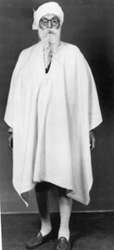





|

|
Another government scheme to get rid of the Sikhs in Canada was subtler. Whenever a Sikh went back to India to get married
or visit his family, he faced difficulties on his return because he could not prove previous residence in Canada. The Canadian
immigration department did not provide East Indians with the proper documentation when they left Canada, although they
systematically registered outgoing Chinese. The policy was deliberately designed to make return more difficult.
The Sikhs had come here to work and to better themselves, not fight a continuing battle with the Canadian authorities, but fight
they must because it was not in the Sikhs’ nature to let injustice go unchallenged. Still, it was an unfamiliar battle. They were
used to fighting face to face; here their adversary assumed many forms and disguises.

|
|
Picture of Teja Singh
|
This called for a different strategy and a change in tactics. In 1909, the Sikhs in British Columbia called in an educated Sikh,
Professor Teja Singh, to lead them in their fight for rights. He had been educated in India as well as in the United States, where
he had earned a Master of Arts degree at Harvard. He possessed the knowledge, skills and experience to help the Sikhs in
British Columbia, having already established temples (gurdwaras) and Sikh communities in many North American cities.
After meeting with Sikh leaders in Vancouver, Professor Teja Singh saw as his first mission the necessity to change the negative
image of the Sikhs in the eyes of the Canadian public. The idea of Sikhs as dirty, uncivilized, low-status rabble not worthy of
being Canadians had to be eradicated. Sikhs must be seen as totally committed to living in Canada and as model citizens.
Professor Singh began by establishing the Guru Nanak Mining and Trust Company to organize and secure the economic
welfare of the Sikh community. The company’s headquarters were at the Vancouver Sikh Temple at 1866 West 2nd Avenue.
Its intentions were:
- To establish the Sikhs, Hindus and Mohammedan in British Columbia, Canada and
the United States on a firm footing; and gain a status for them as a self-respecting
and independent people.
- To bring the wives and children of as many immigrants as possible and settle
them as independent farmers. This with a view to sweep aside one of the most
virulent Canadian objections and also to render the lives of immigrants happier
and to broaden the horizon and sympathies of the women and children.
- To get as many shareholders of the company as possible to donate all or at
least half of their profits for educational and missionary purposes.
According to the company charter of September 1909 its aims were:
- To organize Guru Nanak Hostel for East Indian Students.
- To buy land for farming to settle unemployed workers.
- To invest in mining to get employment for workers.
- To organize their own Trust Company to look after the banking needs of the workers.
- To open their own shopping market to import needed goods from India.
- To organize a Canadian-Indian Supply and Trust company.
- To organize a company of Canadian homebuilders.
|
cont...
[p.3]









|







